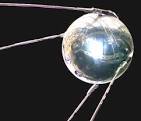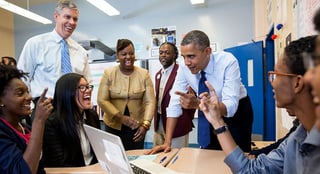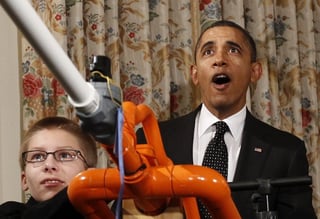Personally, I can't remember a president since Eisenhower that has tried as hard to inspire young people to undertake a STEM career as has President Barak Obama. And yes, I can remember the Eisenhower Administration and the day Sputnik wen t into orbit and changed the world forever! John Kennedy’s administration might have set the nation’s course for the moon in 1961, but I doubt we could have achieved that without the impetus provided four years earlier by Sputnik orbiting the Earth.
t into orbit and changed the world forever! John Kennedy’s administration might have set the nation’s course for the moon in 1961, but I doubt we could have achieved that without the impetus provided four years earlier by Sputnik orbiting the Earth.
And the public was alarmed. Living as I did outside a SAC (Strategic Air Command) base in El Paso, Texas, with a parent working on ground-to-air missiles (Nike was a missile then, not a brand of shoe!) at the White Sands Proving ground, I suddenly found myself intensely interested in rocket propulsion (Looking back at some of my experiments I wonder why I didn’t kill myself; and today I would likely find myself under arrest for constructing pipe bombs--most of the things I built went “boom” rather than up).
A closer reading of history tells us that President Eisenhower, a man who understood the military if anyone did, wasn’t as concerned as the rest of us; he was aware we had a few missiles in the pipeline the the equal or better to anything the Russians had. But to his credit, he is quoted as looking over the educational climate in the country and saying, “People are alarmed and thinking about science, and perhaps this alarm could be turned toward a constructive result."
It was: prior to Sputnik the American public had resisted federal government inroads into what had always been the state's exclusive bailiwick, education; but after Sputnik, the Eisenhower Administration and Congress brought out the National Defense Education Act in 1958. Federal money began flowing to the states for more science, technology, engineering and math; the education industry has never been the same.
In some way Obama’s problems increasing STEM education in the schools were more complicated than Eisenhower’s. For one thing, Eisenhower had the growing fear of Communism and the bomb behi nd him. Obama entered office during the worst recession in decades; the public was more in fear of losing jobs than mushroom clouds. For another, after years of lower taxes Obama had less money to throw around. So he did the one thing that a president without money can still do, he used the “bully pulpit.”
nd him. Obama entered office during the worst recession in decades; the public was more in fear of losing jobs than mushroom clouds. For another, after years of lower taxes Obama had less money to throw around. So he did the one thing that a president without money can still do, he used the “bully pulpit.”
In 2009, President Obama pledged to "restore science to its rightful place." He said, "We will not just meet, but we will exceed the level achieved at the height of the space race , through policies that invest in basic and applied research, create new incentives for private innovation, promote breakthroughs in energy and medicine, and improve education in math and science."
, through policies that invest in basic and applied research, create new incentives for private innovation, promote breakthroughs in energy and medicine, and improve education in math and science."
He became a virtual cheerleader for STEM education. One of his first moves was to approve the first ever, White House Science Fair. As he said in 2009, “If you win the NCAA championship, you come to the White House. Well, if you're a young person and you've produced the best experiment or design, the best hardware or software, you ought to be recognized for that achievement, too.” At the first White House Science Fair in 2010 he spoke of creating “an all-hands-on-deck approach to science, technology, engineering, and math… We need to make this a priority to train an army of new teachers in these subject areas, and to make sure that all of us as a country are lifting up these subjects for the respect that they deserve.” He planned to undertake this by forming the “Educate to Innovate” initiative. He wanted American students to become the best in the world within ten years. Educate to Innovate was formed with the following goals:
- 1. Building a CEO-led coalition to leverage the unique capacities of the private sector
- 2. Preparing 100,000 new and effective STEM teachers over the next decade
- 3. Showcasing and bolstering federal investment in STEM
- 4. Broadening participation to inspire a more diverse STEM talent pool
As he said, it was to be “all-hands-on-deck!” That meant business and industry as well as the government sector and students from every section of the country--including women and inner city youth.
And his cheerleading has seemed to work: over a billion dollars has been spent by the “Educate to Innovate” initiative on STEM education programs for students. In 2015 alone, President Obama announced that the private sector had promised to spend another $240 million to “to inspire and prepare more girls and boys – especially those from underrepresented groups – to excel in the STEM fields.”
President Eisenhower was elected the first time in 1952; President Obama in 2008. In the 1950’s Americans were worried about losing the country’s technological edge over the Soviet Union. Americans in the first two decades of the 21st Century fear losing their technological edge to the whole world, resulting in a reduced standard of living in the near future. Fortunately our country has had the right man in the presidential office at both critical moments.
